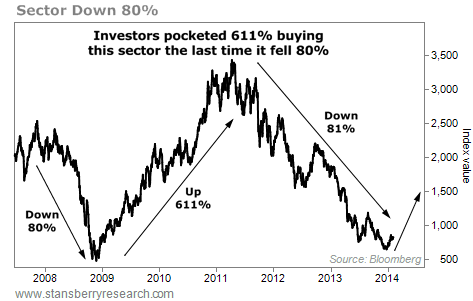| Home | About Us | Resources | Archive | Free Reports | Market Window |
What Happens After a Market Falls by 80% (It's Surprising)By
Thursday, February 6, 2014
What happens to a stock market, sector, or country after it falls by 80%?
My good friend Mebane Faber of Cambria Investments wanted to find out...
He set out to crunch as many numbers on the topic as he could.
His gut told him that stocks would soar... that things would bounce back. But he had no idea just how big the bounce would be...
The results were astounding.
Meb looked back at all instances of stocks falling by 80% – going back nearly a century (to the 1920s).
It turned out, after an 80% fall in a U.S. stock-market sector, the average return three years later in that sector was 173%.
(Meb did the same test on countries, with similarly good results.)
With such amazing numbers, the next question is... Can we take advantage of this today?
Is there a sector that has fallen by 80% recently?
Why yes, there is...
The last time this sector fell by 80%, it rose by 611% not long after.
You might think, "I hear you, Steve, but gains like that will never happen again... That was probably a long time ago."
The thing is, it wasn't a long time ago at all – and yes, those gains can happen again.
It wasn't decades ago when this sector last fell by 80%... In fact, it was actually within the last 10 years. And not much has changed since that last bust and boom.
Take a look:
 This sector fell 80% from late 2007 to late 2008 and then soared 611%.
Recently, it fell 81%... But now it's showing solid signs of an uptrend. It's one of the best-performing sectors year-to-date, but it's still not far off its bottom.
We can easily set up an investment where your downside risk is the recent lows, and your upside potential is hundreds of percent. That's exactly the type of investment we look for...
So what is this sector?
You might be surprised to learn it's junior gold-mining companies.
You know my investing mantra: You want to buy what's 1) cheap, 2) hated, and 3) just starting an uptrend.
Gold-mining companies today meet all three criteria.
Again, the last time junior gold-mining stocks fell by 80% was from late 2007 to late 2008. Importantly, after falling 80%, they then soared by 611% in the next two-and-a-half years.
Could they soar by hundreds of percent again? Absolutely... And I believe they will.
The simplest way to make the trade is through the Market Vectors Junior Gold Miners Fund (GDXJ).
It's around $36 per share as I write. You could set your stop loss at around $30 and leave your upside unlimited for a great risk-versus-reward trade.
Check it out! Your upside potential is truly hundreds of percent!
Good investing,
Further Reading:
Steve recently told readers why he thinks it's time to buy physical gold, too. "The setup doesn't get any better than this," he writes. "This is when you want to buy." Click here for more details.
And on Monday, Steve explained why the recent stock selloff isn't a reason to panic. "Could stocks fall a bit more from here? Absolutely... I can't know the future," he writes. "However, I do believe that this is NOT the start of The Big Bust." Click here to find out why.
Market NotesGOLD-STOCK BEAR MARKET? WHAT GOLD-STOCK BEAR MARKET? If gold and gold stocks have bottomed (as we've been suggesting), it's worth considering Franco-Nevada (FNV) as a way to play a potential rally...
Franco-Nevada is one of the world's premier "royalty firms." Regular DailyWealth readers are familiar with these companies. Royalty firms don't operate mines or explore for mineral deposits. They finance early-stage mining projects and collect royalties when those projects work out. This makes a royalty firm safer and more diversified than a company that "bets it all" on just one project.
To get an idea of how this works, we consult a "performance chart." Today's chart plots the past three years' performance of Franco-Nevada (black line), gold (gold line), and the gold-stock index (blue line). Remember, the gold-stock index consists of many "regular" mining companies.
As you can see, gold itself is down a little over the past three years. Gold stocks in general are down almost 60%. But in an extraordinary display of "bucking the sector trend," Franco is up more than 60%. In other words, a hurricane struck the gold-stock sector... but Franco's house didn't even notice. It's a tremendous display of business and share-price strength.
_N3FA44NE8X.png) |
In The Daily Crux
Recent Articles
|


